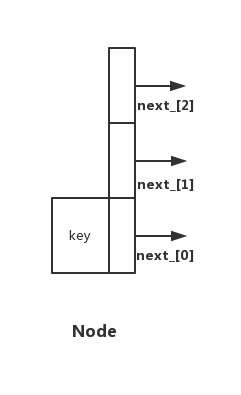levelDB中的skiplist跳表 上
前言
在之前的博客中已经简要介绍了跳表的原理,接下来将介绍跳表在levelDB中的实现。
本小节主要讲一下跳表和其Node的实现结构,关于具体的方法将在下一节中讲到。
代码位置:leveldb-master/db/skiplist.h
深入源码
skiplist结构
template<typename Key, class Comparator>
class SkipList {
private:
//Node结构体声明
struct Node;
public:
// Create a new SkipList object that will use "cmp" for comparing keys,
// and will allocate memory using "*arena". Objects allocated in the arena
// must remain allocated for the lifetime of the skiplist object.
//构造函数
explicit SkipList(Comparator cmp, Arena* arena);
// Insert key into the list.
// REQUIRES: nothing that compares equal to key is currently in the list.
//插入函数声明
void Insert(const Key& key);
// Returns true iff an entry that compares equal to key is in the list.
bool Contains(const Key& key) const;
//省略部分为迭代器
private:
enum { kMaxHeight = 12 };
// Immutable after construction
//比较器
Comparator const compare_;
//内存池
Arena* const arena_; // Arena used for allocations of nodes
//头部节点
Node* const head_;
// Modified only by Insert(). Read racily by readers, but stale
// values are ok.
//整个list的高度
port::AtomicPointer max_height_; // Height of the entire list
//get最高的高度
inline int GetMaxHeight() const {
return static_cast<int>(
reinterpret_cast<intptr_t>(max_height_.NoBarrier_Load()));
}
// Read/written only by Insert().
//在Insert中使用
Random rnd_;
//新建Node
Node* NewNode(const Key& key, int height);
//获取随机高度
int RandomHeight();
//判断是否相等
bool Equal(const Key& a, const Key& b) const { return (compare_(a, b) == 0); }
// Return true if key is greater than the data stored in "n"
//当前key是否在Node之后
bool KeyIsAfterNode(const Key& key, Node* n) const;
// Return the earliest node that comes at or after key.
// Return nullptr if there is no such node.
//
// If prev is non-null, fills prev[level] with pointer to previous
// node at "level" for every level in [0..max_height_-1].
//找与key相等或比key大的节点
//prev用于存放每一层中符合条件Node的前一个Node
Node* FindGreaterOrEqual(const Key& key, Node** prev) const;
// Return the latest node with a key < key.
// Return head_ if there is no such node.
Node* FindLessThan(const Key& key) const;
// Return the last node in the list.
// Return head_ if list is empty.
Node* FindLast() const;
// No copying allowed
SkipList(const SkipList&);
void operator=(const SkipList&);
};
构造函数
在理解了跳表的原理,我们可以知道每一个高度的第一个节点总是head节点。
template<typename Key, class Comparator>
SkipList<Key,Comparator>::SkipList(Comparator cmp, Arena* arena)
: compare_(cmp),
arena_(arena),
head_(NewNode(0 /* any key will do */, kMaxHeight)),
max_height_(reinterpret_cast<void*>(1)),
rnd_(0xdeadbeef) {
for (int i = 0; i < kMaxHeight; i++) {
//给每一个高度上的head_设置next节点为nullptr
head_->SetNext(i, nullptr);
}
}
跳表的结构其实比较简单,其内部成员比较重要的部分是整个List的头部Nodehead_,比较器compare_,内存池arena和一个枚举类型,限制了List的最大高度。(在leveldb实现中用的是height这个单词,为了理解方便我用了层次level这个说法,本质上是没有区别的,但是需要注意的是leveldb之所以称之为leveldb并不是因为跳表的结构,而是sstable的结构)
其中还有一个内部类Iterator迭代器,以及声明的一些函数,我将放在下一节讲这部分内容,接下来先了解一下跳表中的Node节点的结构。
Node-跳表的节点

之前提到,跳表是对链表的改进,在很多实现上其实跳表都和链表类似,但是为了实现跳表的独有特性,在一些地方做了改进。
我们的链表通常有单链表,双向循环链表等,都是比较规整的,而跳表可以说是不太规整,在不同的层次(或是高度height)上来看一个节点指向的next节点是不同的,所以这里使用了一个原子指数组来存放这些next节点,数组的下标值就是Node节点在的当前层次。下面来看源码实现:
// Implementation details follow
template<typename Key, class Comparator>
struct SkipList<Key,Comparator>::Node {
//构造函数,防止隐式转换
explicit Node(const Key& k) : key(k) { }
Key const key;
// Accessors/mutators for links. Wrapped in methods so we can
// add the appropriate barriers as necessary.
//连接的访问器/变异器。用方法包装
//这样我们就可以根据需要添加适当的屏障
//参数n为指定高度
Node* Next(int n) {
assert(n >= 0);
// Use an 'acquire load' so that we observe a fully initialized
// version of the returned Node.
return reinterpret_cast<Node*>(next_[n].Acquire_Load());
}
//设置当前节点的next节点,n指定高度,x为下一个节点
void SetNext(int n, Node* x) {
assert(n >= 0);
// Use a 'release store' so that anybody who reads through this
// pointer observes a fully initialized version of the inserted node.
next_[n].Release_Store(x);
}
// No-barrier variants that can be safely used in a few locations.
//无内存屏障
Node* NoBarrier_Next(int n) {
assert(n >= 0);
return reinterpret_cast<Node*>(next_[n].NoBarrier_Load());
}
void NoBarrier_SetNext(int n, Node* x) {
assert(n >= 0);
next_[n].NoBarrier_Store(x);
}
private:
// Array of length equal to the node height. next_[0] is lowest level link.
//数组的长度等于节点的高度,next_[0]是最底层的link
//AtomicPointer:原子指针
port::AtomicPointer next_[1];
};
数据库管理系统中事务具有四个特性:ACID原子性,一致性,隔离性和持久性。
原子性是指事务是一个不可再分割的工作单元,事务中的操作要么都发生,要么都不发生。
port::AtomicPointer 是一个封装类,其作用是保证操作的原子性。其采用了内存屏障(关于内存屏障这里不介绍太多)来实现同步,其内部成员其实是一个void*类型的指针。
代码位置:leveldb-master/port/atomic_pointer.h
class AtomicPointer {
private:
//内部私有成员
void* rep_;
public:
AtomicPointer() { }
explicit AtomicPointer(void* p) : rep_(p) {}
inline void* NoBarrier_Load() const { return rep_; }
inline void NoBarrier_Store(void* v) { rep_ = v; }
inline void* Acquire_Load() const {
void* result = rep_;
MemoryBarrier();
return result;
}
inline void Release_Store(void* v) {
//使用内存屏障来保证同步
MemoryBarrier();
rep_ = v;
}
};
总结
在之前的博客中讲到了跳表的原理,本节主要讲了一下跳表的结构。
利用数组的下标值来表示高度是非常巧妙的一种做法,虽然跳表的整体结构可能不像链表那么规整,但是其实并不难理解,使用起来也和链表类似。
比如说访问下一个节点,在一般的链表中我们会用Node->next,在条表中实现了next()方法,我们可以使用Node->next(n)来访问,其中的n表示的是高度。
接下来我们将详细介绍跳表中的一些方法。







 本文深入解析LevelDB中跳表的数据结构与实现细节,包括跳表的Node节点设计、构造函数、比较器及内存池的使用。通过分析源码,讲解如何利用数组下标表示高度,以及原子指针确保操作的原子性。
本文深入解析LevelDB中跳表的数据结构与实现细节,包括跳表的Node节点设计、构造函数、比较器及内存池的使用。通过分析源码,讲解如何利用数组下标表示高度,以及原子指针确保操作的原子性。
















 1049
1049

 被折叠的 条评论
为什么被折叠?
被折叠的 条评论
为什么被折叠?








